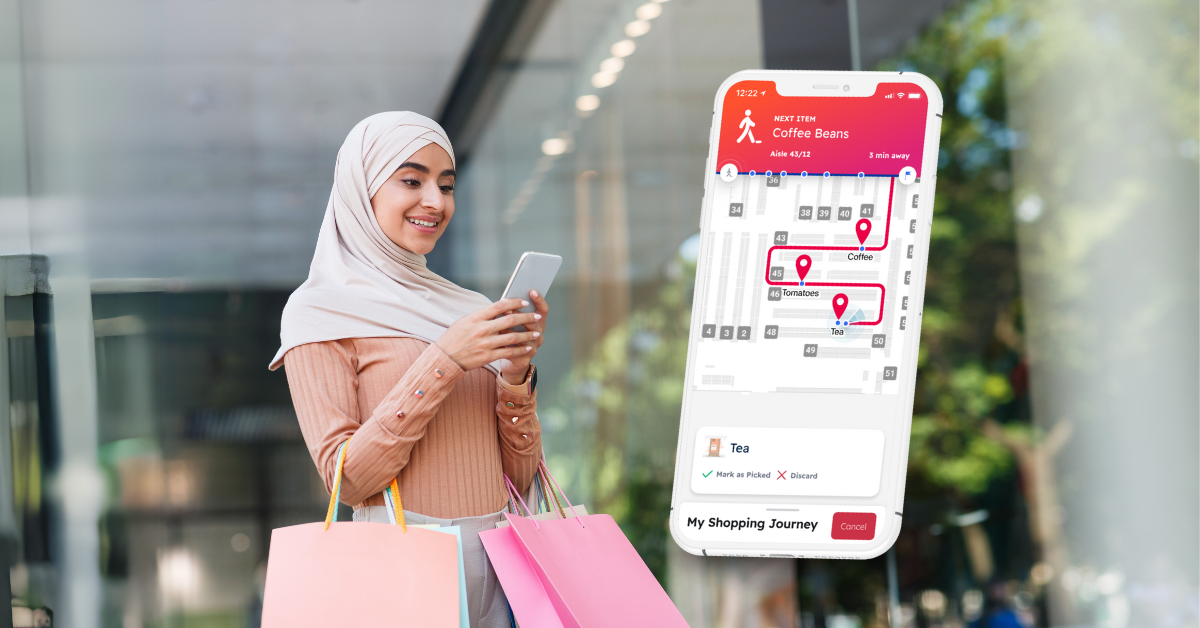How does Indoor Wayfinding Benefit Individuals?

Data of any kind can be essential when it comes to business growth. One of the most sought-after data-driven innovations for physical businesses is indoor wayfinding. Indoor analytics allows finding ways to use interior data to grow many interactions with the help of company intelligence. For example, indoor location data can help business owners more effectively manage customer and employee traffic by letting them know the number of people who visit their store or warehouse daily, the pattern of those visits, and the ratio of new customers to returning customers. However, subjects such as indoor wayfinding and how it differs from GPS are commonly discussed. You can continue reading our article for more information about indoor wayfinding and indoor analytics.
What is indoor wayfinding?
Indoor wayfinding is the process of helping people find their way around a building or other indoor space. It can be done using a variety of methods, including maps, signs, and digital navigation systems.
Indoor wayfinding can be facilitated by a range of technologies, with digital navigation systems being at the forefront. These systems leverage diverse technologies like GPS, Bluetooth, and Wi-Fi to precisely track individuals’ locations and offer real-time directions. Such navigation can be accessed through smartphones, tablets, or specialized devices, ensuring seamless and convenient indoor navigation experiences.
Indoor wayfinding and navigation utilize Bluetooth Low Energy (BLE), WiFi networks, and the earth’s magnetic field within buildings. This allows visitors to navigate through a venue by searching for points of interest or facilities on a digital map. The platform is compatible with battery-powered BLE Beacons or WiFi Access Points that have built-in BLE Beacons.
Why is indoor wayfinding preferred instead of GPS?
Indoor wayfinding is preferred over GPS for several reasons:
- GPS does not work indoors.
GPS relies on receiving signals from satellites, which are blocked by buildings. This means that GPS cannot be used to determine your location inside a building.
- Indoor wayfinding is more accurate.
Indoor wayfinding systems use a variety of technologies, such as WiFi, Bluetooth, and beacons, to determine your location. These technologies are more accurate than GPS, especially in large or complex buildings.
- Indoor wayfinding is more reliable.
GPS can be affected by weather conditions, such as heavy rain or snow. Indoor wayfinding systems are not affected by weather conditions, so they are more reliable.
- Indoor wayfinding is more user-friendly.
Indoor wayfinding systems often use maps and turn-by-turn directions, which are easier to understand than GPS signals.
As a result of these advantages, thanks to our state-of-the-art indoor maps and positioning system, you can now make warehouses, shopping malls, airports, stations, hospitals, and any indoor space more accessible.
With Indoor wayfinding, you can improve your customers’ experience and increase employee safety and productivity, thanks to our state-of-the-art indoor maps and positioning system, enabled by Bluetooth Low Energy and beacons. Users only need a smartphone and an app to utilize the system.
The relationship between Indoor Wayfinding and Indoor Analytics
Indoor wayfinding and indoor analytics are two closely related concepts that can be used together to improve the experience of visitors in indoor spaces.
Indoor wayfinding is a subset technology that is part of the IPera Indoor Positioning solution utilizing Real Time Location Based Services (RTLS). Similar to Google Maps, the Indoor Navigation system, also known as the Indoor GPS, relies on signal strengths from your existing WiFi and BLE network by using sensors on visitors’ mobile devices. Your guests can download your mobile app to use indoor navigation or scan a QR code to navigate through the browser.
Indoor analytics, on the other hand, is the process of collecting and analyzing data about how people move in an indoor space. This data can be used to understand how visitors use the space, identify areas for improvement, and make predictions about future visitor behavior.
Indoor wayfinding and indoor analytics can be used together to create a more personalized and efficient experience for visitors. For example, indoor analytics can be used to track the movement of visitors and identify areas where they are spending a lot of time. This information can then be used to improve the wayfinding signage in those areas, making it easier for visitors to find what they are looking for.
Which sectors prefer indoor wayfinding and indoor analytics, and for what purpose?
Indoor wayfinding and Navigation Software are part of the IPera Starling Indoor IoT Services platform. Indoor Navigation (Indoor GPS) is best used by larger venues such as airports, hospitals, hotels and resorts, shopping malls, stadiums, theme parks, and smart cities. It provides a secure guest experience with turn-by-turn navigation and instructions. IPera Indoor Navigation system is tightly integrated with the Starling Guest WiFi Experience & Analytics platform, helping brands to promote mobile app downloads for better guest engagement and location-based proximity marketing.
As IPera, we shared what you wonder about indoor wayfinding and indoor analytics. Our goal is to provide cloud-based customer interaction and indoor location analytics dashboards. We also develop Enterprise Communication Suite applications that provide Call Accounting, Reporting, Employee Efficiency, Call Recording, and Hospitality Digital Signage, and IPTV Solutions. You can visit our website for detailed information about our services.





